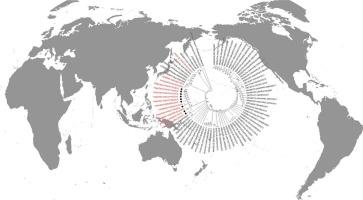2010-2016年中国人腺病毒14型基因组特征及系统发育分析
IF 2.6
4区 医学
Q3 INFECTIOUS DISEASES
引用次数: 0
摘要
人腺病毒(hav)是一种常见的病原体,可引起各种呼吸道疾病。人类腺病毒14型(HAdV-14)是近几十年来出现的,在全球范围内零星和不均匀地报道。2010年,中国首次报道了HAdV-14,但其遗传特征和传播模式尚不清楚。本研究通过将9个新测序的菌株与GenBank中由8个HAdV-14流行国家提交的所有67个HAdV-14菌株的完整基因组序列进行整合,进行了全面的系统发育分析。所有检测菌株均属于HAdV-14p1进化支,该进化支可进一步划分为3个主要聚类。值得注意的是,在中国发现的所有菌株都属于第二和第三类。本研究发现,2010年从中国广州首次分离到的GZ01和GZ02属于聚类II,而通过本研究鉴定的同一地点和年份的GZ25属于聚类III。偶发流行的第三批疫情在中国形成了一个传播圈。尽管两个病毒群之间存在多个关键基因突变,但中国分离株的同源性高达99.7 %。该研究表明,中国所有HAdV-14菌株的衣壳蛋白高度保守,在时间和地理空间上表现出相对的基因组稳定性。本研究提高了我们对HAdV-14的遗传多样性和基因组特征的认识,有助于今后HAdV-14感染的预防和控制。本文章由计算机程序翻译,如有差异,请以英文原文为准。

Genomic characteristics and phylogenetic analysis of human adenovirus 14 in China during 2010–2016
Human adenovirus (HAdV) is a common pathogen that causes various respiratory illnesses. Human adenovirus type 14 (HAdV-14) emerged in recent decades and has been reported sporadically and unevenly across the globe. In China, the first occurrence of HAdV-14 was reported in 2010, yet its genetic characteristics and transmission patterns remain unclear. This study performed a comprehensive phylogenetic analysis by integrating nine newly sequenced strains with all 67 available complete genome sequences of HAdV-14 strains from GenBank, which were submitted by eight countries where HAdV-14 is endemic. All examined strains were found to belong HAdV-14p1 clade, which was further classified into three major clusters. Notably, all strains identified in China belong to Cluster II and III. This study found that the initial isolates GZ01 and GZ02 from Guangzhou, China, in 2010 belonged to Cluster II, whereas the GZ25 isolate from the same location and year, identified through this study, belonged to Cluster III. Cluster III, which was sporadically epidemic, has formed a transmission circle in China. Despite multiple mutations in key genes between the two clusters, the homology of the Chinese isolates reached as high as 99.7 %. This study revealed that all HAdV-14 strains have highly conserved capsid proteins in China, which exhibit relative genome stability across time and geographic space. This study enhances our understanding of the genetic diversity and genomic characteristics of HAdV-14 and contributes to the prevention and control of HAdV-14 infection in the future.
求助全文
通过发布文献求助,成功后即可免费获取论文全文。
去求助
来源期刊

Infection Genetics and Evolution
医学-传染病学
CiteScore
8.40
自引率
0.00%
发文量
215
审稿时长
82 days
期刊介绍:
(aka Journal of Molecular Epidemiology and Evolutionary Genetics of Infectious Diseases -- MEEGID)
Infectious diseases constitute one of the main challenges to medical science in the coming century. The impressive development of molecular megatechnologies and of bioinformatics have greatly increased our knowledge of the evolution, transmission and pathogenicity of infectious diseases. Research has shown that host susceptibility to many infectious diseases has a genetic basis. Furthermore, much is now known on the molecular epidemiology, evolution and virulence of pathogenic agents, as well as their resistance to drugs, vaccines, and antibiotics. Equally, research on the genetics of disease vectors has greatly improved our understanding of their systematics, has increased our capacity to identify target populations for control or intervention, and has provided detailed information on the mechanisms of insecticide resistance.
However, the genetics and evolutionary biology of hosts, pathogens and vectors have tended to develop as three separate fields of research. This artificial compartmentalisation is of concern due to our growing appreciation of the strong co-evolutionary interactions among hosts, pathogens and vectors.
Infection, Genetics and Evolution and its companion congress [MEEGID](http://www.meegidconference.com/) (for Molecular Epidemiology and Evolutionary Genetics of Infectious Diseases) are the main forum acting for the cross-fertilization between evolutionary science and biomedical research on infectious diseases.
Infection, Genetics and Evolution is the only journal that welcomes articles dealing with the genetics and evolutionary biology of hosts, pathogens and vectors, and coevolution processes among them in relation to infection and disease manifestation. All infectious models enter the scope of the journal, including pathogens of humans, animals and plants, either parasites, fungi, bacteria, viruses or prions. The journal welcomes articles dealing with genetics, population genetics, genomics, postgenomics, gene expression, evolutionary biology, population dynamics, mathematical modeling and bioinformatics. We also provide many author benefits, such as free PDFs, a liberal copyright policy, special discounts on Elsevier publications and much more. Please click here for more information on our author services .
 求助内容:
求助内容: 应助结果提醒方式:
应助结果提醒方式:


